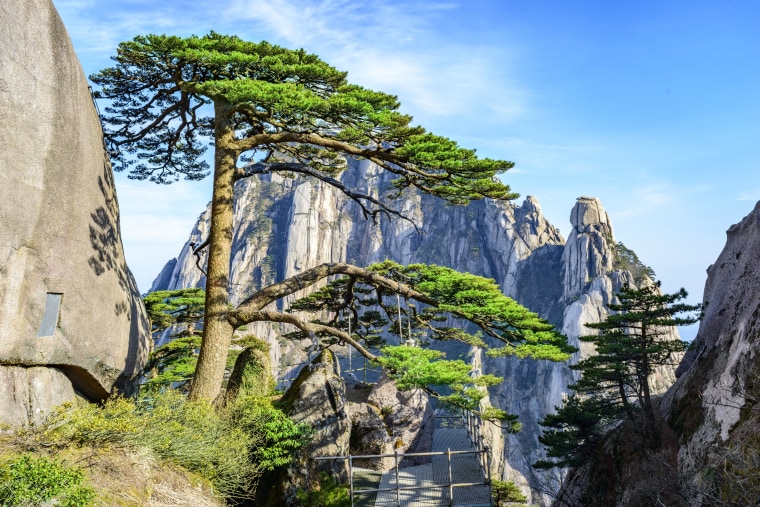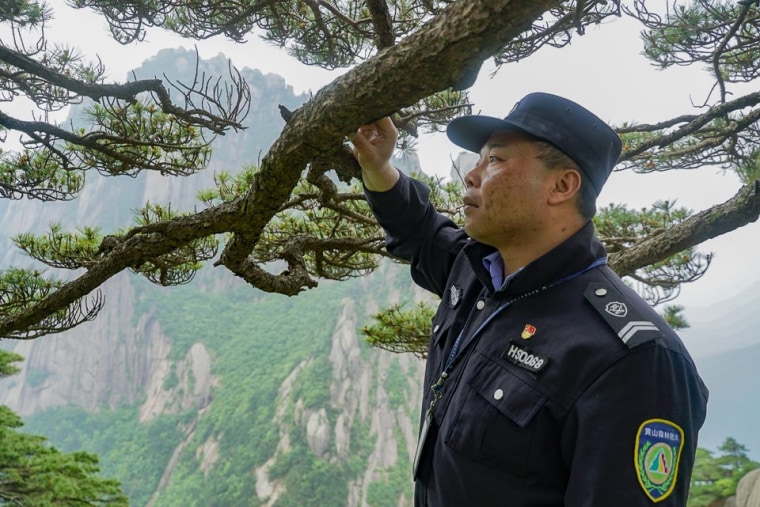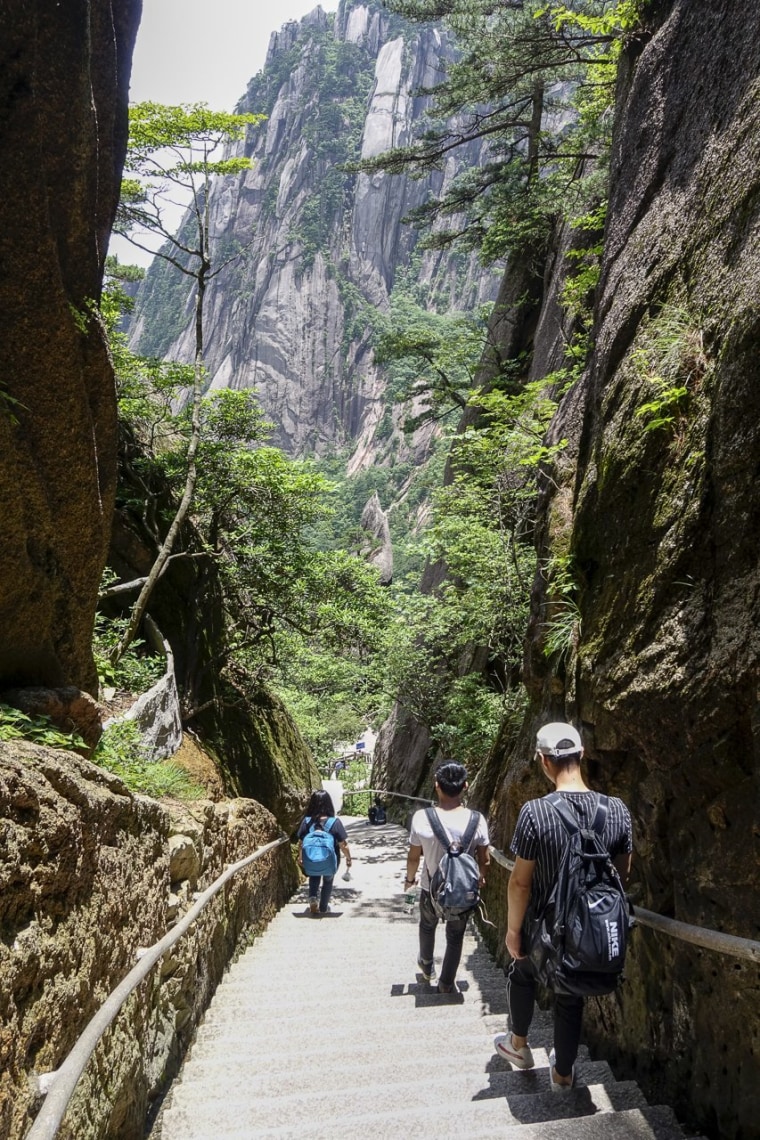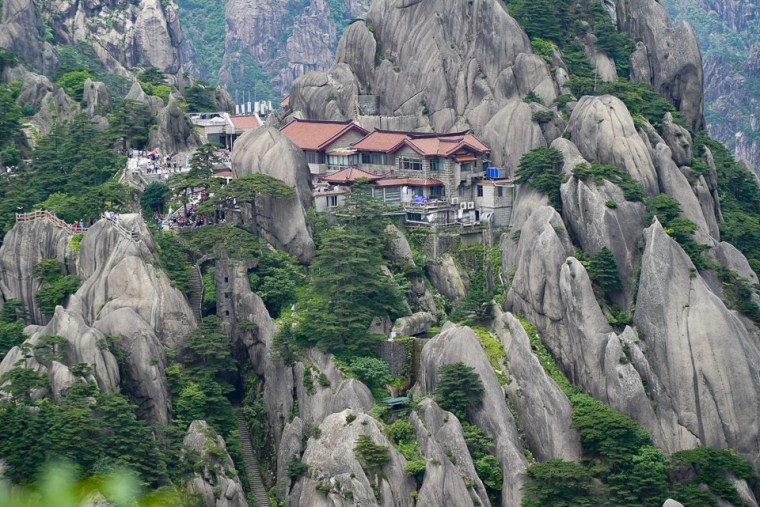HUANGSHAN, China — On one of the world’s most beautiful mountains stands one of China’s most famous trees.
A specimen of rugged, flat-crowned evergreen that may be 1,000 years old, the Greeting Pine — or Yingkesong in Mandarin — overlooks a dramatic landscape of granite peaks and mist-shrouded valleys of Huangshan.
The tree is so well-known, it even has a bodyguard — Hu Xiaochun, the 19th Guardian of the Pine.
“My main job is to protect and monitor the Greeting Pine everyday,” Hu told NBC News.

When he's on duty, every two hours, every day of the year, Hu has to inspect the tree and log details about its condition and the local environment. He also guards the tree from squirrels and monkeys that could damage its branches, and he’s there to support it through snowstorms and typhoons.
While protecting the Greeting Pine from animals and monitoring for disease takes patience — and a high-tech motion-detection and surveillance system — Hu’s biggest challenge isn’t a vigorous animal looking for a new home. It’s getting people to leave the tree in peace.
Tourists love the Greeting Pine. They love it so much, they may be loving it to death.
“Human sweat damages the bark, and we are trying to ensure that it keeps growing naturally," Hu said.
Although Hu is supported by a team of 20 — including specialized arborists — the primary responsibility for the tree’s health falls on his shoulders.

As income levels rise, ever-increasing numbers of Chinese are starting to travel domestically. Tens of millions of tourists now flock to China’s national parks every year.
More than 3.3 million people traveled to Huangshan in Anhui Province in 2016, according to the local tourism bureau. And almost all of these visitors invariably pause for a portrait or a selfie in front of the Greeting Pine.
Dr. Zhan Dongmei, a specialist in scenic areas at the China Tourism Academy, said the "concepts of environmental protection and sustainable eco-tourism" did not exist when the tourism industry was established four decades ago.
Air pollution in major cities like Beijing may be the more visible indications of China’s struggle to contain the damage wrought by its rapid industrialization, but scenic areas like Huangshan are increasingly on the front lines in the battle to protect the country’s natural beauty and environment.

“Famous scenic sites often have millennia of history as sacred sites,” said Dr. Judith Shapiro, a researcher at American University and the author of "China’s Environmental Challenges."
“These places have always been desirable destinations for their landscapes and spiritual values," she said. "What has changed is that the Chinese now have disposable income to allow them to travel for pleasure, and these sites are becoming inundated with commercial enterprises and the tourists who use them. As a result some sites are being ‘loved to death.’”
China’s government is increasingly focused on environmental issues.
In October, President Xi Jinping gave an annual speech to the National People’s Congress — roughly analogous to America's State of the Union address. Over three hours, Xi mentioned the environment or related terms 89 times, according to an analysis by Bloomberg Intelligence, while mentioning the economy only 70 times.
China must “ensure that the ecology and environment are fundamentally improved by 2035, and that our goal of building a beautiful China is basically achieved,” Xi told the People’s Congress.
This is a marked shift from the growth-at-all-costs philosophy that has been at the core of Beijing’s economic policy over the past 40 years, since Deng Xiaoping initiated the pragmatic reforms aimed at transforming to a market economy. While the lifting of hundreds of millions out of stark poverty is among the greatest achievements of the modern Chinese state, rapid growth and industrialization have come at a cost.
Chinese metropolises are consistently ranked among the unhealthiest places in the world to live because of air pollution, and citizens are becoming less and less worried about vociferously asserting their right to live in a clean environment.

“Environmental mass incidents” that range from minor protests to major outbreaks of civil unrest now number in the thousands each year, according to research published by the Wilson Center’s China Environment Forum.
In May 2014, thousands of people took to the streets in Hangzhou — just over 100 miles east of Huangshan — to decry the opening of a new coal power plant. Demonstrations turned violent as protesters clashed with security forces, leaving dozens injured.
The linkage between quality of life and public security has not been lost on the authorities, and is part of the reason Beijing is taking a keen interest in speaking publicly about environmental issues.
“The central government is basically telling people to be patient,” Shapiro said, adding that crackdowns on local officials have resulted in hundreds of arrests for those found to be in “noncompliance” with anti-pollution laws and environmental regulations. “The central government is sending the message that the people should trust them to deal with the middle and lower levels of officialdom, who are not obeying the laws.”
Additionally, Chinese officials must now prove to the central authorities that they are making progress based on environmental standards if they hope to gain promotion within the party. That is a shift from even a few years ago, when the primary metrics for success were economic growth and social stability.
Improving those metrics shouldn’t be hard, in theory: China has some of the world’s toughest and most stringent environmental laws on the books, and hundreds of geographic locations fall under a variety of environmentally protected designations.
But researchers note that many of these “national parks” exist primarily on paper: “Extractive activities” like logging or mining still continue, sacrificing natural beauty and biodiversity for profit.
The issue is one of enforcement and implementation.
“Simply limiting the number of visitors will not relieve the pressure,” Zhan said. The key, she explained, was in designing “smart” tourist sites in areas of natural beauty that enabled local authorities to manage access and control the flow of visitors. This requires planning and effective implementation by those charged with overseeing the parks.

Managing a balance between environmental sustainability and economic growth is a visible challenge on Huangshan mountain, where an endless stream of tour groups pushes against the fence guarding the Greeting Pine trying to get a better look.
Hu Xiaochun understands their interest.
“Whenever I’m away from home, for example during the time I was serving in the army, every time I told someone I was from Anhui, the first thing flashed across their mind would be Huangshan,” Hu said. “And when they think about Huangshan, the first thing that appears in their mind is the Greeting Pine.”
But he shrugs philosophically as he pushes through the crowd.
“I can only protect it, and guard its life,” he said. “What I am doing here is a unique job. Guarding the pine is like guarding my family.”